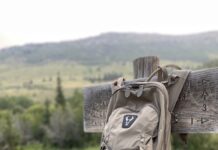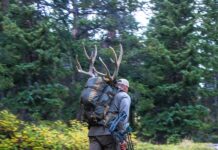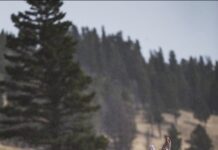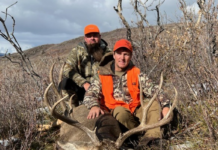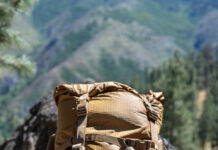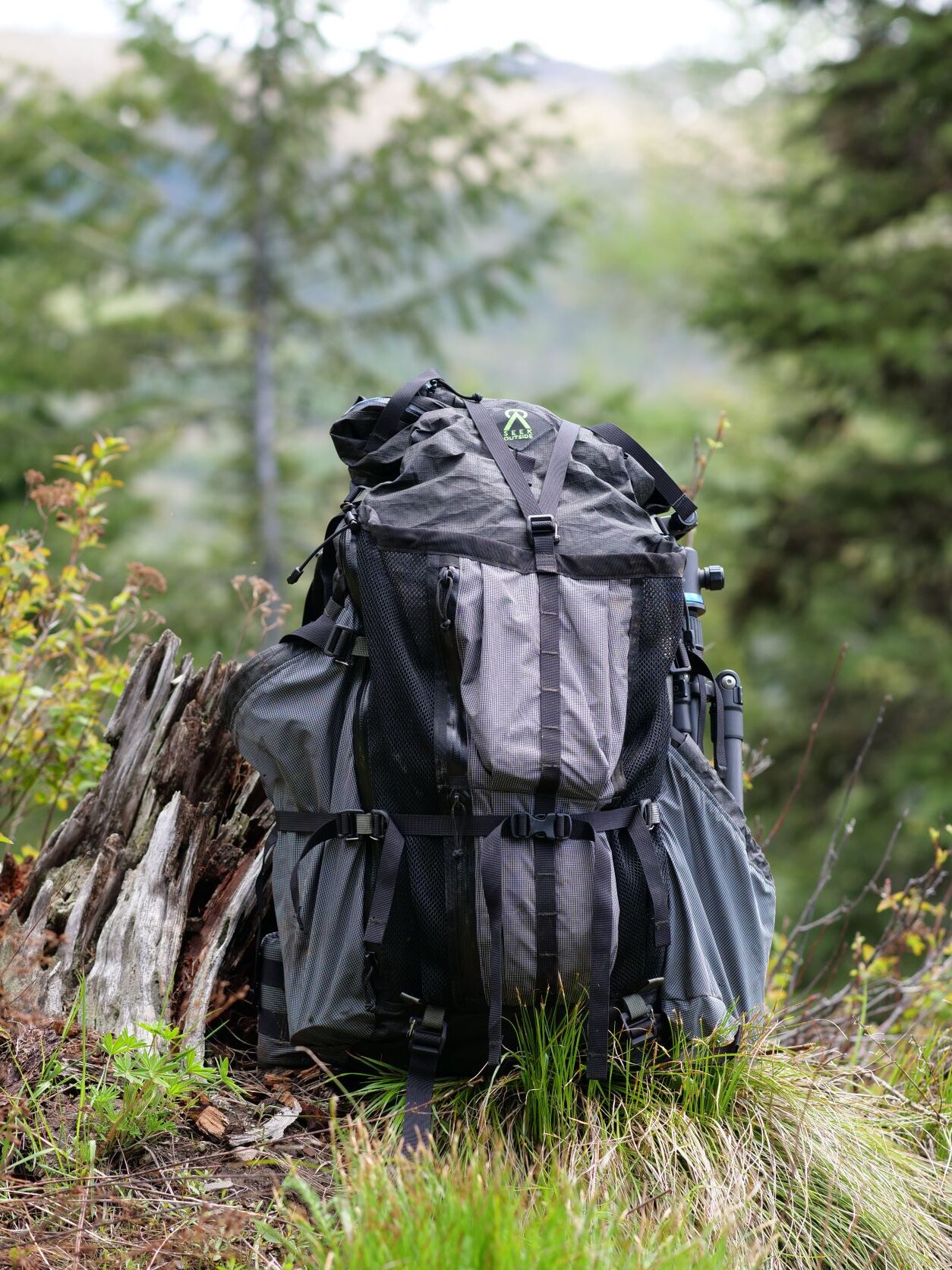 I killed the headlights and eased into the inky blackness of a small turnout along the remote forest road. My dimmed headlamp narrowly lit the world as I double-checked my gear and strapped my bow onto the outside of my pack. A three-hour trip into a remote basin awaited. The night before, I had scrutinized every piece of gear and pared my pack to a minimum in order to travel fast and light. I was glad I did because by mid-morning, I was armpit deep in brush, face-to-face with a screaming bull, and ready to pursue him wherever needed.
I killed the headlights and eased into the inky blackness of a small turnout along the remote forest road. My dimmed headlamp narrowly lit the world as I double-checked my gear and strapped my bow onto the outside of my pack. A three-hour trip into a remote basin awaited. The night before, I had scrutinized every piece of gear and pared my pack to a minimum in order to travel fast and light. I was glad I did because by mid-morning, I was armpit deep in brush, face-to-face with a screaming bull, and ready to pursue him wherever needed.
Seek Outside Kenai 5400
Keeping gear trim and light is the strategy I employ when making long solo trips into the mountains, where every bit of weight savings is welcome. Everything is at risk of replacement when I see something lighter, stronger, or more efficient hit the market: game bags, cordage, headlamps, shelters. This year a new pack with impressive specs caught my eye. I arranged with Rokslide for a review, and had it in hand by April for a season of testing.
A few years ago, I extensively tested a Seek Outside Lanner 5400 and became familiar with its design. It’s a large volume pack built on SO’s Revolution frame where the bag separates from the frame (labeled a “break-away” design) and has a load shelf between the frame and the bag. The pack used and tested this season (2022) is a Seek Outside Kenai 5400. The bag on this pack is an “integrated” model where the load shelf is internal to the bag and the Revolution frame. This cohesive setup is simpler in design and is 8 ounces lighter, but does require everything to be carried internally including meat.
New Fabrics
2022 was a large leap forward in material spec’d in the pack line with the use of UltraPE 400 fabric. In the Kenai, it is used in the main bag while the belt, harness, and side pockets are made with Spectra Grid HT fabric. The UltraPE replaces the X-pac fabric with a 40% reduction in weight and an 4X increase in tear strength. The Spectra Grid is similar in performance to 500d Cordura but lighter and more water resistant. These are significant advances in material characteristics in backpack design and construction. More can be read here.

Features and Design
The frames, belts, and harnesses in Seek Outside hunting packs are the same for the integrated and break-away packs. Like the previous test pack, the Kenai came with standard 24-inch aluminum stays and 2-inch removable extensions were used when the loads got over 60 pounds. The belt is a medium which fits my 33-inch waist, and comes with a small buckle with four-way forward pull straps. A removable lumbar pad was added to fit my back profile.

As mentioned above, the bag is built of UltraPE 400 fabric and is basically a Lanner in the integrated configuration. It has a roll top closure, full side zip access, a hybrid mesh face pocket with zippered security pockets, and a small zippered pocket on the roll top shroud.
Like the Lanner, there are two large side pockets but on the Kenai, they are asymmetrical with the left being taller for tripods and spotters and the right shorter for easy water bottle access. The full specs can be found here. The pack as assembled including internal load shelf and extra gatekeeper straps, weighs 4.75 pounds.

The Kenai is designed as a 10-day pack with a 5400 in3 main bag which compresses into a very trim day hunting pack. The three zippered pockets and face pocket (1000 in3) offer convenient organization and quick access to gear. The internal hauling of heavy loads is simplified with a clip-in load shelf and is adjustable in height allowing for versatility.
Compression Straps
The straps (6 side compression, 2 bottom compression, and 1 over-the-top compression) are removable with gatekeeper buckles at each end of the strap allowing for a custom configuration depending on load compression needs.

Use In The Field
The pack was tested extensively throughout the 2022 season. Spring bear hunting in Idaho and Montana was extremely wet and occurred in rough cliffy terrain. Patches of burned timber, thick with fire-sharpened limbs, was an extreme test of the new fabrics’ durability and waterproofness.
Summer hiking season provided opportunities to optimize fit, load configuration, and repeatedly put wear on the zippers, buckles, and fabric.
September through November I was carrying backcountry loads through heavy brush and loading the internal load shelf with elk and deer quarters; which evaluated long-term comfort, durability, and ease of use. The tally was over 50 days of use with 8 days packing heavy loads of meat.
Durability
The new UltraPE 400 fabric has been incredibly durable. The fabric of the main bag has remained wear and tear free during its use cycle. The same can be said of the Spectra Grid fabric with the exception of one spot on the left pocket where there are a few snags in the grid. This occurred in the spring when I fell down a brushy hillside fully loaded, trying to traverse a thirty-year-old burn in the dark. The amount of abuse these new fabrics have received and survived can’t be stated enough.

The new material has been extremely water resistant and has kept the interior dry in all but the multi-day rain storms. A mid-October rainstorm ended with water penetrating the interior via the seams. Seam sealing will eliminate water issues and allow for usage without an exterior rain fly.
The UltraPE 400 is softer and more supple than X-pac in all temperatures allowing for a quieter experience when opening and closing the bag. The external face of the fabric is softer as well and creates less noise than X-pac when brush and branches scrap across the surface; similar to a well-worn Cordura fabric. The internal face of the UltraPE is smooth and doesn’t absorb moisture making blood cleanup extremely easy. Overall, the new fabrics used on the Kenai are a major step in a positive direction.
Comfort & Functionality
Like the previous Seek Outside pack, I prefer the belt in the floating configuration. With day loads or backpacking loads, the belt configuration wasn’t noticeable, but with heavy weights, the floating configuration wraps around my iliac crest better and transfers weight to my waist more efficiently. On successful hunts, the majority of the loads I carry out of the mountains are in the 75 to 85-pound range where the pack feels comfortable and balanced.

With these weights, the small front waist buckle uncomfortably digs into my waist. Swapping to a larger quad buckle is more comfortable and maintains the ability to tension the top and bottom straps individually. End-user preference will vary; if the standard small buckle design isn’t comfortable, be aware there are options.

As an integrated pack, heavy loads of meat ride internally in a removable and adjustable load shelf. The Spectra Grid shelf clips onto sewn loops in the bag via gatekeepers and has longer straps to connect and snug the load to the top of the frame. The loads ride close to the frame and against the spine, with the center of gravity maintained in the optimal position.
Frame Extensions Add Versatility
The 2-inch frame extensions need mentioning as they are worth adding when the loads get heavy. I prefer to hunt in the 24-inch configuration for better overhead clearance, but when heavy loads are strapped in, adding the frame extensions allow for more lift, control, and comfort. Frame extensions of 2 inches or 4 inches can be added to the main 24-inch frame. For reference, my torso length is 17.5 inches, and the 2-inch extensions are enough to get proper lift.

Shoulder Straps
The shoulder straps are well padded, comfortable, and perform well on the Kenai. The suspension and waist belt didn’t cause any hot spots or pressure points from slippage or poor fit. The frame, harness, and belt remain creak-free at their attachment points. The frame stays distortion free when fully loaded thanks to the frame cross stay which also promotes air flow along the back. The ventilation of the frame is similar to other packs on the market with the warmest spot being in the harness area and waist belt.

1 to 10 Day Hunts With The Same Pack
The volume of the Kenai bag is substantial and can easily handle a 7 to 10-day hunt. The volume shines when an elk quarter needs to be added to the mix with camping gear. It takes a deliberate approach to pack gear efficiently around the meat, but the full-length side zipper is really helpful for this task. With all of the gear and meat in the same space, it’s judicious to pack a small dry bag to protect sleeping gear from blood.
Although it’s a 5400 ci bag, day hunts are not overly cumbersome with its ability to compress with straps and the roll-top lid. The side pockets are generously sized and the left pocket easily holds a spotting scope and tripod. The shorter side pocket on the right is used to stash a large bugle tube for easy retrieval, Nalgene bottles, or occasionally a rifle buttstock. The spacious mesh face pocket is mostly used for stashing layers as they get shed throughout the day.

Seek Outside Gatekeeper System
In the 2019 testing of the Lanner pack, I was skeptical of the gatekeeper system’s durability, although I didn’t encounter any failures. Since then, the gatekeeper buckle design has increased in sturdiness with minimal increases in weight. With the Kenai, I’ve cranked hard on the compression straps and have not had any failures, even surprisingly when a buckle is mistakenly left unlatched. The ability to customize the amount and position of them is really convenient. Despite their recognized benefits, I still prefer a fixed buckle and strap. The constant clipping and unclipping are slower and more cumbersome, especially when wearing any glove. The compression straps that cover the side zipper tend to be in the way and must be removed for full access to the back. It’s a minor annoyance but a continual one.

Ideal User
The ideal user of this pack is someone looking for an incredible light, large, multi-day bag utilizing durable, cutting-edge fabrics. When seam-sealed, it can eliminate the use of the rain fly and is ideally suited for hunters in wet climates.
The bag volume to pack weight ratio is ideal for hunters who have physically demanding hunts and need room for large amounts of gear. The bag will ingest bulky cold-weather gear without an issue. The simplicity of the integrated bag-to-frame configuration is ideal for hunters who don’t want the complexity of an external load shelf and is okay with meat riding internally with other gear. The pack is also well suited for the minimalist who wants the lightest pack available and is venturing out on long adventures.

The Seek Outside Kenai 5400 retails for $585, including the frame, harness, waist belt, and bag. The lumbar pad is $39, and the 2-inch and 4-inch stay extensions are $10 and $15. Check out their website for updated lead times on a pack.
Comment or ask Josh questions here and check out the rest of our pack reviews here.




